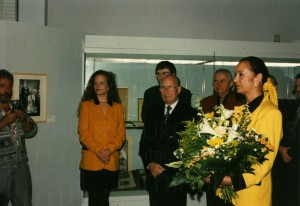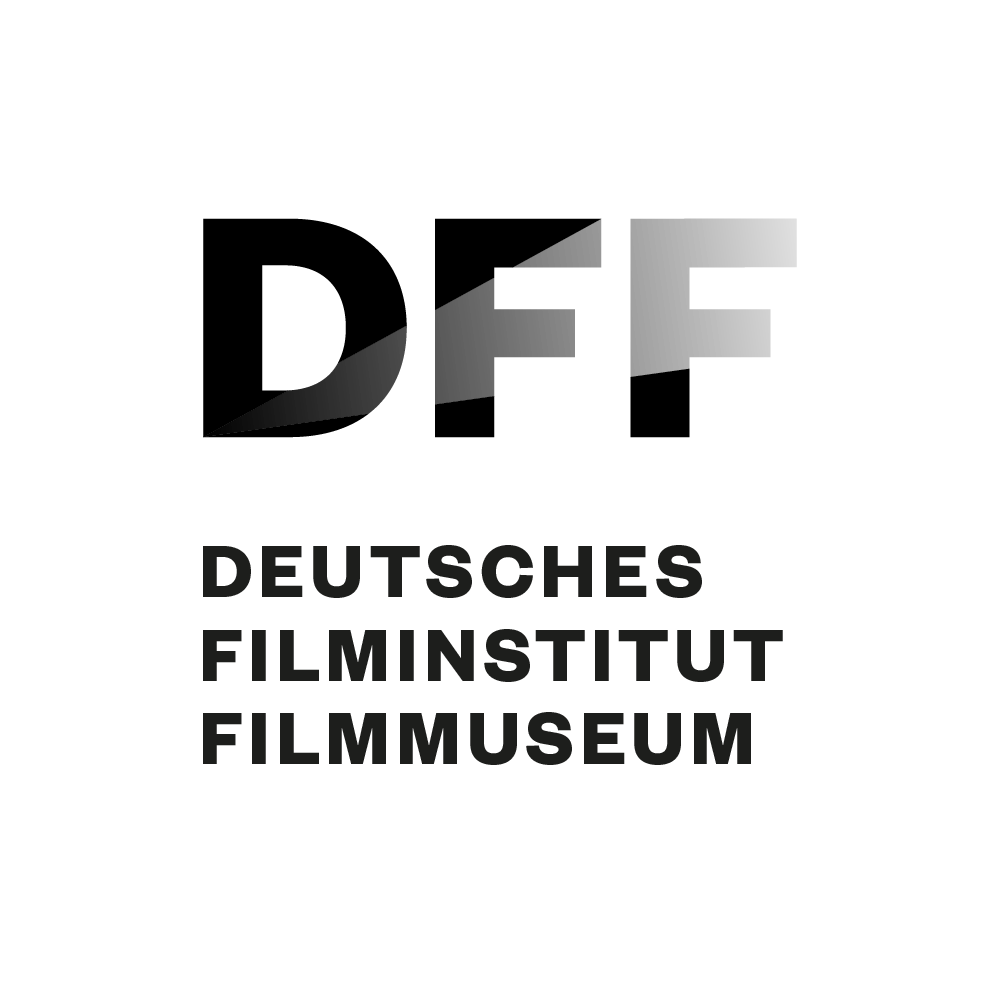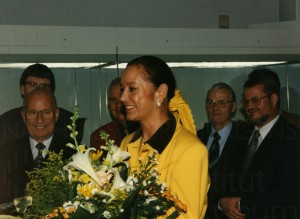Der Nachlass
Die werkbezogenen Dokumente und Objekte aus dem Besitz von Curd Jürgens, die 15 Jahre nach seinem Tod in die konservatorische Obhut des Deutschen Filmmuseums kamen, sind vollständig in einem detaillierten Bestandsverzeichnis erfasst und stehen der weiteren wissenschaftlichen Auswertung zur Verfügung.
Der bis Juni 1997 in Jürgens’ Villa in Südfrankreich aufbewahrte Nachlass kam größtenteils ungeordnet in das Archiv des Deutschen Filmmuseums. Eine erste Sichtung der in 40 Holzkisten verpackten Materialien bestätigte die Vermutung, eine aussagekräftige und filmhistorisch bedeutende Sammlung vorzufinden.
Im November 1997 erfolgte die offizielle Übergabe an das Museum, verbunden mit einer ersten öffentlichen Präsentation ausgewählter Stücke. Die Gesamterfassung und konservatorische Sicherung dauerte über zwei Jahre.

Miriam Duncan (l.) und ihre Mutter Margie Jürgens bei der bei der Erstpräsentation des Nachlasses im Deutschen Filmmuseum, 1997
Im Nachlass finden sich Materialien zu einem Großteil von Curd Jürgens’ Arbeiten am Theater, für den Film und das Fernsehen. Ein vermutlich von ihm selbst 1935 begonnenes, großformatiges Scrapbook dokumentiert anhand von eingeklebten Film- und Theaterfotografien sowie Presseausrissen und Korrespondenzen die ersten zehn Jahre seiner Schauspielerkarriere. Neben über 3000 Szenen- und Werkfotos, rund 70 Drehbüchern und Skripten, 45 Plakaten, zahlreichen Programmheften und anderem werkbezogenem Schriftgut, einem Konvolut von Schriftwechseln zu realisierten Theater-, Film-, und Ferseharbeiten sowie sämtlichen verliehenen Preisen und Auszeichnungen, bieten die ebenfalls im Nachlass erhaltenen Textbücher und Korrespondenzen zu nicht realisierten Projekten Einblick in den Verlauf der Künstlerlaufbahn. So befindet sich im Nachlass unter anderem ein Brief des Regisseurs Max Ophüls, der Aufschluss über ein (erfolgloses) Casting von Jürgens für den Film LOLA MONTÈS (Lola Montez, 1955) gibt.
Wie sehr sich Jürgens nicht nur als Schauspieler mit Theater und Film auseinandersetzte, zeigt ein umfangreiches Konvolut mit Manuskripten und Notizen, darunter das Manuskript zu dem in den 1940er Jahren von ihm verfassten Theaterstück “Geliebter Michael” ebenso wie ein handschriftlich geführtes Buch mit Entwürfen zu Filmprojekten, das auch das Exposé zu seiner ersten Filmregie PRÄMIEN AUF DEN TOD (1950) enthält.
Des weiteren dokumentieren Aufzeichungen zu der Autobiografie “… und kein bißchen weise” und das Verlagsmanuskript des 1980 erschienen Romans “Der süße Duft der Rebellion” die schriftstellerischen Ambitionen des Weltstars. Auch der Sänger Curd Jürgens ist mit Schallplatten im Nachlass vertreten, darüber hinaus sind Schallplattenaufnahmen von Lesungen der “Schachnovelle” (Stefan Zweig, 1942) und des “Steppenwolf” (Hermann Hesse, 1927) erhalten geblieben.
Aufschluss über Curd Jürgens’ Leben in der direkten Nachkriegszeit bieten unter anderem Korrespondenz mit der Familie, ein Konvolut von Geschäftsunterlagen und Dokumenten von 1946 sowie ein Tagebuch aus dem Jahr 1947. Hierbei finden sich Quittungen für Lebensmittelmarken und Anträge für Bezugsscheine über zwei Paar Schuhe, drei Anzüge und drei Hemden, die Jürgens mit der Begründung stellte, dass er sie unbedingt für seine Arbeit als Schauspieler benötige.
Schließlich befinden sich neben den werkbezogenen Materialien auch persönliche Gegenstände und Dokumente im Nachlass, beispielsweise über 2300 PR- und Privatfotografien, Tagebücher und Terminkalender ab 1959 bis zu Jürgens’ Tod 1982, eine „Lebendmaske“ aus den 1950er Jahren, aber auch ganz private Objekte wie seine Pfeifen samt Pfeifenbesteck oder ein gerahmtes Heiligenbildchen – ein Geschenk von Romy Schneider.
Sichten, ordnen, registrieren und beschreiben – das Archivieren eines Nachlasses ist auch Spurensuche. Viele Zusammenhänge ergaben sich während der Arbeit, wichtige Hinweise lieferte die Auswertung des umfangreichen Pressematerials, manches blieb lange verschlossen. Fotos, Aufzeichnungen und persönliche Dokumente zeigen neue Aspekte, beleuchten den Star und den privaten Curd Jürgens aus einem ungewohnten Blickwinkel, vielfach dokumentieren sie Bekanntes. Das vorliegende Material, welches in dieser virtuellen Ausstellung erstmals online präsentiert wird und somit eine weltweite Zugänglichkeit erfährt, erlaubt einen sehr persönlichen Einblick in das private wie öffentliche Leben des Filmstars und illustriert die Stationen seiner Karriere.
Alle Materialien des Nachlasses, die in der virtuellen Ausstellung als Digitalisate präsentiert werden, können in unserem Archiv in Frankfurt am Main eingesehen werden.
Isabelle Bastian / Hans-Peter Reichmann


